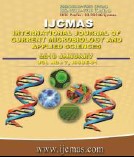


 National Academy of Agricultural Sciences (NAAS)
National Academy of Agricultural Sciences (NAAS)

|
PRINT ISSN : 2319-7692
Online ISSN : 2319-7706 Issues : 12 per year Publisher : Excellent Publishers Email : editorijcmas@gmail.com / submit@ijcmas.com Editor-in-chief: Dr.M.Prakash Index Copernicus ICV 2018: 95.39 NAAS RATING 2020: 5.38 |
Otitis media is an inflammation of the middle ear cleft without reference to etiology or pathogenesis. Otitis media is more common in children, as their Eustachian Tube is shorter, narrower and more horizontal than the adult ear. Therefore, the study of microorganisms commonly associated with CSOM and their antibiotic sensitivity pattern is vital for the clinician to plan a general outline of treatment for the patient with a chronically discharging ear. Hence the aim of our study is to find out the fungal and bacterial aetiology and their antibiotic susceptibility pattern in clinically diagnosed CSOM cases in tertiary care hospital at Jaipur. The present study was carried on total of 53 clinically diagnosed CSOM cases attending ENT Department. After proper sample collection by sterile cotton swabs, they were immediately sent to the microbiology laboratory for aerobic bacterial culture, isolation and identification Conventional bacteriological and Mycological methods were used for identification of CSOM and susceptibility testing was performed as per CLSI guidelines 2017. This study comprises of 45 isolates of CSOM from total of 53 clinical specimens, collected from in- patients attended to ENT department during a period of 6 months. The most common organism causing CSOM among aerobic bacteria were Pseudomonas species i.e. 16 (29%) then Staphylococcus aureus 11(20%). In fungi most common organism isolated was Aspergillus niger then Candida albicans. Meropenem was most effective 100% against gram negative bacilli. In Pseudomonas Ticarcillin/Clavulanic Acid, Ceftazidime, Colistin and Polymyxin-B were 100% sensitive. Linezolid, Vancomycin and Rifampicin were 100% effective against gram positive cocci. The periodic evaluation of microbiological pattern and their antibiotic sensitivity pattern in local area becomes important and helpful in prescribing empirical antibiotics for successful treatment of CSOM and thus minimizing its complications and emergence of resistance strains.
 |
 |
 |
 |
 |